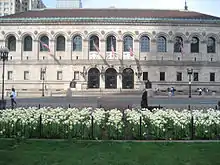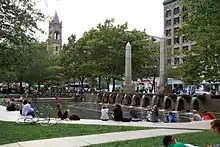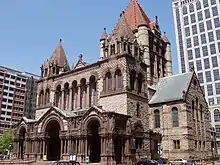Copley Square
Copley Square /ˈkɒpli/,[1] named for painter John Singleton Copley, is a public square in Boston's Back Bay neighborhood, bounded by Boylston Street, Clarendon Street, St. James Avenue, and Dartmouth Street. Prior to 1883 it was known as Art Square due to its many cultural institutions, some of which remain today. It was proposed as a Boston Landmark.



Architecture
Within the Square are several architectural landmarks:
- Old South Church (1873), by Charles Amos Cummings and Willard T. Sears in the Venetian Gothic Revival style
- Trinity Church (1877, Romanesque Revival), considered H. H. Richardson's tour de force
- Boston Public Library (1895), by Charles Follen McKim in a revival of Italian Renaissance style, incorporates artworks by John Singer Sargent, Edwin Austin Abbey, Daniel Chester French, and others
- The Fairmont Copley Plaza Hotel (1912) by Henry Janeway Hardenbergh in the Beaux-Arts style (on the site of the original Museum of Fine Arts, Boston)
- The John Hancock Tower (1976, late Modernist) by Henry N. Cobb, at 790 feet (240 m) (241 m) New England's tallest building
- The Bostix Kiosk (1992, Postmodernist), at the corner of Dartmouth and Boylston streets, by Graham Gund with inspiration from Parisian park pavilions[2]
Notable buildings later demolished:
- Chapel Hill – Chauncy Hall School (c. 1874, demolished 1908), a tall-gabled High Victorian brick school building on Boylston St. near Dartmouth Street
- Museum of Fine Arts (1876, demolished 1910) by John Hubbard Sturgis and Charles Brigham in the Gothic Revival style, was the first purpose-built public art museum in the world.
- S.S. Pierce Building, (1887, demolished 1958) by S. Edwin Tobey, "no masterpiece of architecture, [but] great urban design. A heap of dark Romanesque masonry..."[3]
- Hotel Westminster, Trinity Place, by Henry E. Cregier of Chicago in 1897;[4][5] now replaced by the northeast corner of the new John Hancock Tower.
History

A significant number of important Boston educational and cultural institutions were originally located adjacent to (or very near) Copley Square, reflecting 19th-century Boston's aspirations for the location as a center of culture and progress.[6] These included the Museum of Fine Arts, the Massachusetts Institute of Technology, Harvard Medical School, the New England Museum of Natural History (today's Museum of Science), Trinity Church, the New Old South Church, the Boston Public Library, the American Academy of Arts and Sciences, the Massachusetts Normal Art School (today's Massachusetts College of Art and Design), the Horace Mann School for the Deaf, Boston University, Emerson College, and Northeastern University.
Known as Art Square until 1883,[7] Copley Square was originally cut diagonally by Huntington Avenue; it took its present form in 1961 when Huntington Avenue was truncated at the corner of Dartmouth Street, the Square partially paved, and a pyramidal fountain sculpture added.[8] In 1991, after further changes including a new fountain, the new Copley Square Park was dedicated. The nonprofit Friends of Copley Square raises funds for care of the square's plantings, fountain, and monuments.
The Boston Marathon foot race has finished at Copley Square since 1986.[9] A memorial celebrating the race's 100th running (in 1996) is located in the park, near the corner of Boylston and Dartmouth streets.[10]
Boston Marathon bombing
On April 15, 2013, around 2:50 pm (about three hours after the first runners crossed the line) two bombs exploded—one near the finish line near the Boston Public Library, the other some seconds later and one block west. Three people were killed and at least 183 injured, at least 14 of whom lost limbs.
Transportation
Copley is served by several forms of public transportation:
- Copley Station on the MBTA Green Line
- Several MBTA bus routes; the square is a major transfer point and terminal for several local and express routes
- Logan Express to Logan International Airport
- Nearby Back Bay station for MBTA Orange Line, MBTA Commuter Rail, and Amtrak
Major roads:
References
- https://www.youtube.com/watch?v=KAhCeSDx8eU
- Mary Melvin Petronella, ed., Victorian Boston Today: Twelve Walking Tours (Northeastern University Press, 2004), 69, available onlime, access September 9, 2012
- Robert Campbell and Peter Vanderwarker. Coming into Copley. Boston Globe. Mar 26, 2006. p. BGM 16.
- "Chicago Man's Reputation". Boston Evening Transcript. Feb 3, 1900. p. 7. Retrieved 4 May 2015.
- Shand Tucci, Douglass (1978). Built in Boston (First ed.). New York: New York Graphic Society. p. 102. ISBN 978-0821207413.
- Douglass Shand-Tucci, The Gods of Copley Square, lecture series, 2009, sponsored by Back Bay Historical/Boston-centric Global Studies and the New England Historical Genealogical Society
- "Archived copy". Archived from the original on 2013-09-15. Retrieved 2013-07-01.CS1 maint: archived copy as title (link)
- Jim Botticelli (2014). Dirty Old Boston: Four Decades of a City in Transition. Boston: Union Park Press. p. 115. ISBN 9781934598122.
- Powers, John (April 16, 2010). "Evolution of the Boston Marathon finish line". Boston Globe. Retrieved 19 October 2012.
- Boston Marathon Memorial, Boston Art Commission, 100 Public Artworks, p. 3
Further reading
- Aldrich, Megan. Gothic Revival. Phaidon Press Ltd: 1994. ISBN 0-7148-2886-6.
- Bunting, Bainbridge. Houses of Boston's Back Bay: An Architectural History, 1840-1917. Belknap Press of Harvard University Press: 1967. ISBN 0-674-40901-9.
- Forbes, Esther, and Arthur Griffin. The Boston Book. Houghton Mifflin Company: 1947.
- Holtz Kay, Jane. Lost Boston. Houghton Mifflin: 1999. ISBN 0-395-96610-8.
- Shand-Tucci, Douglass. "The Gods of Copley Square: Dawn of the Modern American Experience, 1865-1915", www.backbayhistorical.org/Blog, 2009.
- Shand-Tucci, Douglass. "Built in Boston, City and Suburb, 1800-2000". Little, Brown. (Third edition) 1999.
- Shand-Tucci, Douglass. "Renaissance Rome and Emersonian Boston: Michelangelo and Sargent, between Triumph and Doubt", Anglican Theological Review, Fall 2002, 995-1008.
- "Greetings from Copley Square: A Chronology in Postcards", Exhibitions, Boston Public Library, 2010
External links
| Wikimedia Commons has media related to: |

